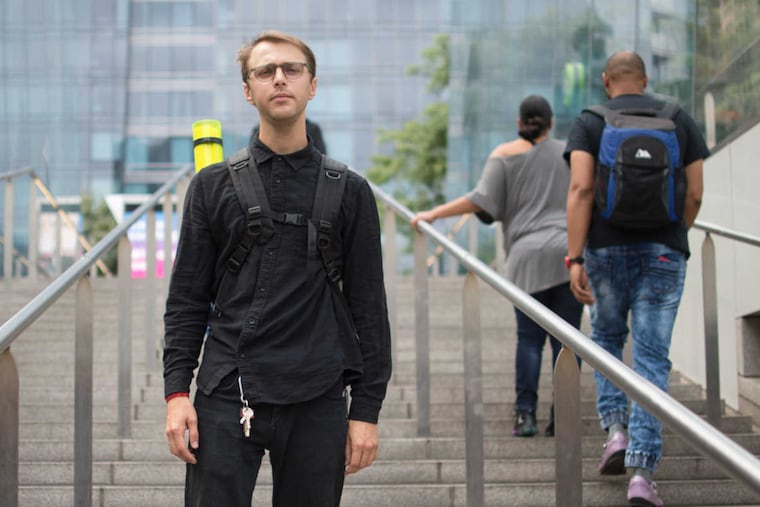Meet the man behind the stealth art show under Philly's City Hall
Once a week, Ryan Greenberg, 27, prowls the City Hall station's dingy passages, filling empty frames with art.

Kisha Hall glanced up from her iPhone, alarmed, as Ryan Strand Greenberg loomed over her at City Hall's trolley platform.
He reached for the empty frame on the pale brick wall behind her and slid in a portrait.
"I didn't know what he was doing," Hall, 22, laughed after Greenberg, a Philadelphia photographer who's spent the last four months decorating the platforms beneath City Hall with pictures, stepped back.
Once a week, every week, Greenberg, 27, prowls the City Hall station's dingy passages, filling empty frames with art. The frames, ranging in size from 11 by 17 inches to 22 by 22, are there for public service announcements and ads, but often go unused, he said.
Where travelers see a blank silver surface, Greenberg spots an opportunity to provide access to art beyond the sometimes stuffy confines of an art gallery.
"If one in every 20 people see it up there, it's still a lot more people who see it than in a private space," he said.
Greenberg, of South Philadelphia, studied at the Art Institute of Philadelphia and had stints shooting for news organizations and an advertising firm before deciding in 2015 to devote himself full-time to freelance and fine arts photography. As a public transportation user, he was particularly drawn to the platforms and tunnels under City Hall, a hub where trolleys, the Broad Street Subway, and the Market-Frankford El converge.
"It's the ephemeral quality of people passing through space and seeing these pictures or not seeing these pictures," he said. "I like the idea in general of there being some discovery with these things."
Sometimes he seeks to contrast colors in the photo with trim on the otherwise-white walls. The photos are often portraits, and the subjects have included an elderly woman with a leaf blower in Louisiana and a man on a train in Hungary. Occasionally he'll mount nature photos — water, leaves, and trees — an antidote to the close confines of SEPTA's urban caverns.
His project, "Photography Starting at $2.50," with a name inspired by the subway's fare price, is distinct from street art like graffiti tagging, but he acknowledged that there's a guerrilla element to it. He's using SEPTA's frames without the agency's permission, which he said gives him freedom about what to post. He tries to wait until SEPTA workers are out of sight before slipping his work into the frames. So far, he said, he hasn't experienced any confrontations.
SEPTA officials learned about Greenberg's project from a blog posted this week and said they're going to be on the lookout — to remove his work.
"There is a formal process people have to go through in order to advertise," said Carla Showell-Lee, SEPTA's spokeswoman, who noted SEPTA also has an official public art program. "If they haven't, we have to remove it, regardless of how nice it is to the naked eye."
She wasn't sure if SEPTA staff had already been taking down the pictures, but said the authority required workers to take pictures of unfamiliar items placed in the notification frames and, if the images haven't been sanctioned by SEPTA, to remove them. She said SEPTA would be open to working with Greenberg if he wanted to pay to post his work.
SEPTA's policy, though, suits Greenberg fine. His photographs stay up typically no longer than a week, and he likes the impermanence of their display. Viewing them is a temporary opportunity he likened to the experience of photography itself, a camera capturing an image that exists only for a moment.
And at least some of his photos aren't ending up in SEPTA's trash bins. He's heard from people who saw his work, liked it, and took the prints home with them.
When Greenberg approached the frame on the wall behind Hall, she was hunched over her smartphone, earbuds inserted. After a startled glance at Greenberg, she turned back to her phone. When asked about the picture, though, she looked up and turned around.
"It looks nice," she said, smiling.